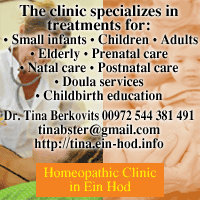Positive Health Online
Your Country

Gentle and Natural Birth Induction Part I
by Dr Tina Berkowitz(more info)
listed in women's health, originally published in issue 178 - January 2011
Introduction
To appreciate the gentle and natural birth induction it is important to understand the role of the different hormones that are released by the foetus, stimulated glands, placenta, and the brain of the mother before, during and after birth. It is also imperative to comprehend the movement of the foetus and the role of the muscles involved in childbirth to fully grasp the technique.
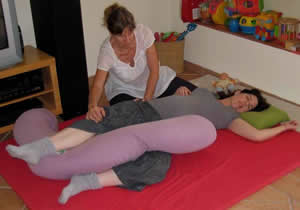
Dr Tina Berkovits with a client in labour, with contractions coming every 7 minutes
As with conventional interventions there has to be a certain readiness of mother and foetus, and good timing for the natural and gentle induction technique to work efficiently.
The evaluation is usually done by an experienced therapist together with the treating physician, midwife, and/or other conservative methods. Only then is the method of gentle and natural induction treatment decided upon and performed according to the presented condition.
The treatment may include manual stimulation, oral intake, breathing techniques, coaching and guided imagery. Assuming the reader is informed with the birthing process, this article starts with the techniques themselves and ends with some additional relevant background information.
The Treatment
After having an understanding of the psoas muscle importance, the role of hormones, the cardinal movements of the foetus, the movement of the head through the pelvis, we can continue to the treatments, which obviously concentrate on facilitating optimal conditions for all of the above.
Most of the times the birthing mother's state of mind ensures the physical, mental, and emotional conditions for the facilitation of a safe birth and this is an intricate part of the evaluation and thereafter the treatment.
So how do we set about creating an optimal environment?
Obviously the therapist cannot relax a client and neither can she/he change the hormonal secretions or move the baby into the right position. All the above have to be done by the mother and the foetus.
The therapist can only help facilitate relaxation of the mother, facilitate a gentle birth process, facilitate a relaxed state of mind by ensuring a safe and comfortable environment. The mother herself has to relax, feel safe, feel comfortable and thereafter enable secretion of the hormones necessary to facilitate the birth of the baby.
Manipulations of the body can help the mother relax the psoas muscle; soothing touch can help the mother release hormones that are beneficial for the birth experience. A good talk and cry before birth can help ease fear and release tightened ligaments and muscles.
One of the manual treatments that help induce the optimal environment for a natural birth experience is reflexology.
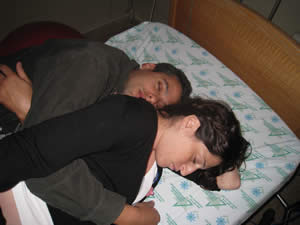
Reflexology
The method of reflexology treatment depends on the week the mother arrives, and is slightly different for either the preparation towards induction, or a gentle and natural method of induction at the due date or later.
There are some points that are stimulated after the baby is full-term and overdue.
The Reflexology treatments for birth preparation are done in the 36th week and include:
- Hormonal balance with special attention on reflex point of pituitary gland and ovaries;
- Massage of the uterus reflex point;
- Stimulation of the lower spine reflex point;
- Stimulation of the symphysis pubis reflex point;
- Stimulation of the hip joint reflex point;
- Stimulation of the sacral plexus reflex point;
- Stimulation of the colon reflex points;
- Relaxation technique.
Acupuncture Synchronized with Reflexology
When the baby is overdue and the contractions have not yet started, deep pressure technique can be used and acupressure points added to reflex points (also acupuncture), in synchronization with the above reflexology points.
The Relevant Points are:
- SP 6 (medial calf)
3 cun, 4 fingers ,directly above the tip of the medial maleolus, on the posterior border of the medial aspect of the tibia; - LI 4
On the dorsum of the hand, between the 1st and 2nd metacarpal bones, approximately in the middle of the 2nd metacarpal bone on the radial side; webbing between thumb and index finger; - KI 3
In the depression between the medial maleolus and tendon calcaneus, at the level with the tip of the medial maleolus; - UB 60 (between lateral maleolus &Achilles tendon)
In the depression between the external maleolus and tendon calcaneus; - GB 21
Midway between Dazhui (DU 14) and the acromion, at the highest point of shoulder; in the middle between shoulder and C7 of shoulder; - GV 20 / DU 20(on top of head)
On the midline of the head, 7 cun directly above the posterior hairline, approximately on the midpoint of the line connecting the apexes of the two auricles; on top of head (lifts the spirit); - UB 67
On the lateral side of the small toe, about 0.1 cun posterior to the corner of the nail; outside lower corner of the little toe nail .
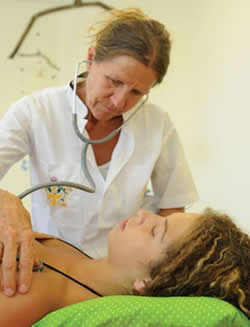
Acupuncture Treatment
Use deep pressure technique on uterus reflex points and simultaneously stimulate or massage the pituitary gland reflex point. Strongly pulling the heel and pushing back of toes can also be applied.
The points are manually stimulated for about 30-45 minutes after massaging the feet till they are warm and flexible. The points can be needled with acupuncture needles before or after the reflexology treatment. Make sure the feet are warm and stay warm also after the treatment.
A short note for the reflexology therapist: the reflex points listed above are according to the original works of E Ingham.
Another aspect of the reflexology mapping would be superimposing the female reproductive organs (cervix, uterus, Fallopian tubes and ovaries) onto both feet as a whole, and then use these as focal points for the treatment.
After Gentle Induction through Reflexology
After and during the reflexology treatment, contractions often start, though it may sometimes take about 3 sessions in a row to get things going. If the client has come in for treatments a week before the due date, the induction is done even more gently, and gradually increased in strength according to the condition of foetus and mother.
Rocking
After the Reflexology treatment 'Rocking' induces tranquillity and relaxation of all muscles. This is done with the client lying first on the right, then on the left side (or first on the left, then on the right). Each individual vertebra (especially in the areas of the psoas muscle insertion T12 and L4); then muscles and joints of shoulders and pelvis should be released, until the whole length of the spine, shoulder and pelvic girdles are completely relaxed and move smoothly in synchronization.
A rule of thumb rule is: Only when the tip of the nose quivers while gently rocking the body, the mother is completely relaxed.
At the end of the rocking treatment the body should be fully supported by the therapist and gently moved back and forth (as in a cradle) to induce a kind of sleepy hypnotic state.
The client feels either very light or heavy depending on stress, fatigue, tension, and general energy, but always comfortable and relaxed and "'right'.
During contractions the 'Rocking' is continued and can be accompanied by guided imagery that has been introduced to the client at the beginning of all sessions when meeting the first time.
1-3 treatments are usually enough to induce contractions. They also help reduce pain to about 50% or more - sometimes less - during active labour.
Clients have reported they would still feel the contractions, but not the full force of the pain. The contractions were not being experienced as intolerable, and it was easier to ride them out.
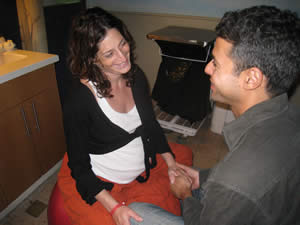
RMT® - Repetitive Movement Therapy
RMT® addresses dopamine release and its tension-releasing influence on the body while at the same time it induces a hypnotic kind of state in the mother.
The movements are called stereotyped movements, which means, they look the same, and they are repetitive and rhythmic.
Some Background:
Dopamine is absolutely critical to the way our brain controls movements. Shortage of Dopamine causes Parkinson's disease, in which a person cannot execute smooth, controlled movements.
The repetitive movements of bicycle-riding introduced to Parkinson patients ameliorated Parkinson symptoms considerately.
The hormone Dopamine is responsible for the control of movement, and also for the feelings of pleasure and emotions.
Dopamine stabilizes brain activity and regulates the flow of information to other parts of the brain. It is similar to adrenaline in its activation of dopamine receptors.
Dopamine is produced in the tegmental areas of the brain and the area of substantia nigra, which in turn projects it into the basal ganglia which are responsible for the execution of stereotyped movements.
There are some disorders related to stereotyped movements.
The causes of these disorders are basically unknown, but there are several theories. Many of the behaviours may be associated with normal development.
For example, up to 80 percent of all normal children show rhythmic activities that gradually decrease by the age of 4 years. These rhythmic movements seem to be purposeful and pleasurable and provide sensor motor stimulation, as well as some kind of tension release to the children. The movements sometimes increase at times of frustration, boredom, or tension.
Dopamine is connected with the pleasure system of the brain, the frontal lobes. This means it provides feelings of enjoyment and reinforcement which motivates us to do or to continue doing certain activities. Also, when aversive or unpleasant stimuli are encountered, dopamine is released. This suggests that it is not associated only with pleasure.
Dopamine is also released when a pleasurable activity is expected to happen. This tells us that the activity does not even have to actually take place for dopamine to be released. Therefore, it could be more involved in 'desire' rather than 'pleasure'.
Having understood the connection of pleasure release of tension and repetitive, stereotyped movements, the therapist can now initiate this state of pleasure by moving any part of the body rhythmically and repetitively back and forth, which will thereafter increase the secretion of Dopamine. This has to be done very gently and the rhythm is of course individually adjusted.
The technique is useful also for the mother at birth, when contractions become more painful; then the use of repetitive and stereotyped movements, rhythmic breathing or moans can help her through the immense pains of contractions. She doesn't think about the movements, but they develop instinctively and involuntarily, precipitating the intense feeling of pleasure and release of tension after the birth. The movements can be compared to the repetitive and rhythmic movements leading to orgasm, or during sexual intercourse, during intense pain, mourning and trance-like conditions.
Manipulation of the Psoas Muscle
Manipulation of the psoas is done by holding the foot and gently rotating the leg outward or inward.
The manipulation is first done on the leg which is rotated slightly outward, a sign of a less tight psoas. Working on the 'healthy' side, will help the mother relax, since it is a completely painless and gentle manipulation. Often the mother will drift into a sleepy state of mind during the rotation, which in turn will help ease manipulation of the tight psoas on the other side.
After completing the rotation of the 'healthy' leg, attention is now given to the tight psoas of the other leg at the hip joint. The manipulation has to be firm but gentle. If too much pressure is exerted it can be painful and cause more tightening of the muscle. Great care has to be taken not to rotate the lower leg - from the knee down - only, which will then cause injury to the knee.
Manipulation of the psoas muscle is first done via the leg's rotation, affecting the hip joint and then by rotating the hip joint at the pelvis.
At the same time the hip joint and pelvis are manipulated, the buttock (gluteus) and back muscles relax and eventual back pain is relieved.
As a therapist, one has to remember that the area of the psoas muscle at the groin is one of the points where emotions are physically expressed and held in the body. Stretching and strengthening exercises will hardly release tension in the psoas muscle. Since the brain controls tension and relaxation of the muscle, the brain has to be addressed through the manipulation, and a different kind of movement has to be introduced via a passive movement method. The area is usually tight and because of the postural strain during pregnancy, can become tighter and cause pain in the back and groins.
When manipulating the hip and pelvis for the relaxation of psoas muscles, it can cause a confrontation of the mother with her fears, anger and other emotions and bring about tears or laughter.
This in itself can sometimes be confusing, embarrassing and/or painful for the mother and cause the psoas to become tight again.
Gentle encouragement, soft words and tranquillity is needed at that stage of treatment and a different approach for the relaxation of this significant area can help too.
Try to swing the leg - bent at the knee, foot flat on the table - back and forth. The leg has to be well supported by the therapist to give the mother the feeling of confidence. The tightness and tension is felt immediately by the therapist and mother; now great patience is needed to overcome the psoas muscle tension. No amount of prodding will help, only patience and giving confidence on an emotional level will release the muscle and joint.
If the treatment is done in the right environment and gently, the psoas and tight ligaments will relax and the pelvis will be free to move and facilitate the lightening and descend of the foetus.
Breathing Exercise
A great part of the gentle and natural induction method is learning to breathe into the lower abdomen - all the way down to the bikini line. Every woman responds to a different instruction / image for this kind of breathing. Note: This is not the breathing exercises studied in childbirth education classes, but is a more specifically controlled breathing method.
While the therapist places her / his hand right above the bikini line (with the permission of the mother) the mother is instructed to:
- Breathe into the cervix;
- Breathe into the hand placed on to the lower abdomen;
- Breathe for the baby;
- Breathe in and out through the vagina;
- Open the lungs to the side while inhaling;
- Open the nostrils while inhaling;
- Exhale towards the perineum.
While breathing into the lower abdomen, a lot of concentration is needed. The mother turns inward and learns to centre herself, which is a great help also for later when contractions are stronger.
The therapist should pay attention that the mother does not hyperventilate (expiration has to be at least 2x longer than inspiration).
The centred breathing exercise together with the relaxation of the psoas at the hip joint will again help free the pelvis of tight muscles and ligaments, facilitating the downward movement of the foetus.
Aromatherapy
Any kind of aromatic oil introduced at an earlier stage, before the actual induction stage, is beneficial for the mother, if and when she enjoys the scent and it induces a happy and calming energy. In general, it is better to infuse the room with the scent of the oil than apply it onto the skin of the mother. Even though a massage blend of Rose and Neroli is relatively safe, and can help induce tranquillity and calm, it is sometimes better to inhale the oils via a burner or diffuser. Some oils may help give energy and strength to an exhausted mother who is in the process of giving birth. The choice of oils is individual and is discussed with the client.
Here are a few oils that are safe to use:
Fennel: according to Pythagoras smelling the oil will ease birth pain;
Clary sage: inhaling this oil will help increase uterine contraction at the last stage of labour;
Chamomile: inhalation of the oil is good for over-excitement and stress;
Ho leaf: can be used for fright before or during labour;
Neroli and Rose: are safe oils for young children and can be used during pregnancy, though sparingly.
Rosemary and lemon: blended together are great as air fresheners, antimicrobial in an hospital environment and energy inducing when exhaustion sets in;
Spearmint: has an uplifting quality and is also safe to use.
Home Remedies
In addition to the manual treatments described above, there are some things the mother can do at home. Here are some very beneficial and helpful remedies to use after the due date has passed and the mother is scheduled for a conventional induction in the hospital.
It is important to mention, no scientific evidence does exist that states home remedies for induction are effective as an induction method.
Sexual Intercourse
Sexual intercourse has long been a method of inducing labour, making use of the prostaglandins found in the semen and cervix during orgasm stimulating contraction. It is generally more relaxing and enjoyable than being induced with medication in a hospital. It will not harm the baby, and can open the cervix up to 2cm.
Nipple Stimulation
Nipple stimulation is a safe and gentle induction method by following the protocol below.
- Roll nipples between thumb and forefingers for 2-3 minutes;
- Rest for 3-4 minutes.
The period of resting or stimulation can be gradually increased or decreased depending on the effect
Enemas: enemas have been used by experienced midwives for ages with great success and are relatively safe. They cause the muscles of the bowels to contract, affecting and stimulating the uterus at the same time. Use with caution. If you are not used to laxatives it might cause violent diarrhoea and distress.
Exercise: Walking, swinging in a swing and general exercise helps stimulate the uterus. Squatting for short periods is helpful. Hula or belly dancing works great, as does washing the floor on all fours or weeding the garden. Climbing stairs and skipping down again is a great exercise to get the pelvis moving and helping the foetus rotate downwards. Make sure not to over-exert yourself; strength is still needed for the birth process.
A bumpy car ride works well and is also fun for the mother since she can lie down or sit in the back seat and enjoy the ride.
Pineapple: Eating lots of pineapple is reputed to begin labour and ripen the cervix. It probably has to do with the enzyme bromelain found in the fruit. Make sure it doesn't give you heartburn; eat it in small bites or drink the juice in small sips first to find out. Preferably not on the day of birth!
Cumin Tea: This is used by midwives in Latino cultures. Traditionally, a raw cube of potato is added to the tea which absorbs the bitterness of the cumin. Some sugar or honey will make this drink more palatable.
1 T. cumin seed to one cup of boiling water, allow to steep for 5 minutes, then drink. No more than 1 cup per day.
Castor Oil: Three teaspoons of castor oil is about right; try mixing it with some juice or pour it over a salad (tuna salad is a good alternative). Note: castor oil can give you cramps and diarrhoea; it is a strong laxative and may cause a violent reaction and labour.
Water: The role of water is to give energy to the mother, prevent abortion, help keep amniotic fluid at the desired levels and relieve pain during labour.
Homeopathy and Childbirth Related Issues

Dr Tina Berkovits during a homeopathic consultation in Namibia
Pulsatilla
This remedy corrects the inability of the uterus to expand and enables the child to turn and descend head first into the birth canal prior to delivery.
During the 33rd week (the seventh month), the mother can take Pulsatilla 30 CH once a day for a few weeks, initially in granules, but after that in energized liquid form.
From weeks 33 to 36 there is still time for the child to turn without stress.
If the child has still not descended by week 36, one dose of Pulsatilla 200 CH can be taken - again start with granules and repeat in the liquid energized form 10 days later. In this way, Pulsatilla may help avoid breech and other abnormal presentations.
These time guidelines generally apply to the first pregnancy, though not always!.
In subsequent pregnancies the child may not descend and engage until later, but Pulsatilla may still help facilitate proper positioning of the infant prior to birth.
Pulsatilla: when contractions are irregular and weak, the cervix is slow to dilate and the mother feels miserable, clingy and tearful; she may talk about wanting to give up and go home!
Natrum muriaticum can help to induce labour or strengthen ineffective contractions. It can be helpful with postpartum bleeding and a reluctant placenta.
Black cohosh is often used to relieve irregular contractions and encourage stronger contractions (If this causes nausea and/or lightheadedness, discontinue.)
Blue cohosh helps increase uterine tone; (can also cause nausea/light-headedness - mothers should discontinue use of this remedy if they experience any of these side effects.)
Chamomile encourages relaxation and promotes sleep; some experts feel that this herb as a tea is gentle enough to use in moderation anytime after the first trimester.
Disclaimer
The article on birth induction is purely for informational purposes and is not intended as a substitute for advice from a physician or other health care professional.
No information in this paper on birth induction is intended for the diagnosis or treatment of any health problem, for health assessment, for prescription of any medication, or for any other health treatment. Consult with a healthcare professional before starting any diet, exercise or supplementation program, before taking any medication, or if you suspect you might have a serious health problem. You should never stop taking any medication without first consulting your physician.
Further Information
Supporting articles from:
www.childbirthconnection.org
www.bellybelly.com
www.motherandchildhealth.com
http://somatics.com/psoas.htm
www.birthsource.com
www.acupunctureproducts.com/acupuncture_meridians.html
Editor's Note: Part II, to be published in the following Feb Issue 179 will discuss The Role of Hormones, The Brain, Cardinal Movements and The Psoas Muscle
Comments:
-
No Article Comments available
